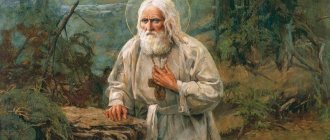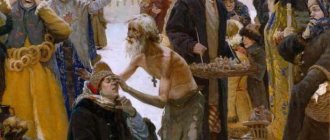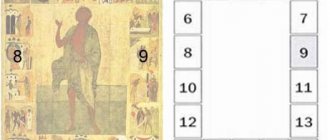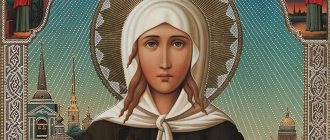Blessed Nicholas of Pskov, Salos, Fool for Christ's sake
Brief Life of Blessed Nicholas Sallos
He was originally from the Pskov land. Through his petition to Tsar Ivan the Terrible in 1570, the disgraced city of Pskov was saved from destruction. Saint Nicholas died on February 28, 1576.
The Complete Life of Blessed Nicholas Sallos
Blessed Nicholas of Pskov carried out the feat of foolishness for more than three decades. Long before his death, he acquired the grace-filled gifts of the Holy Spirit and was awarded the gift of miracles and prophecy. His Pskov contemporaries called him Mikula (Mikola, Nikola) Sallos, which translated from Greek means “blessed, holy fool,” and during his lifetime they revered him as a saint, also calling him Mikula the Holy.
In February 1570, after a devastating campaign with the oprichnina army against Novgorod, Tsar Ivan the Terrible moved to Pskov, suspecting treason and preparing the fate of Novgorod for him. As the Pskov Chronicle testifies, “the king came... with great fury, roaring like a lion, wanting to tear apart innocent people and shed much blood.”
The whole city prayed to avert the king's wrath. Hearing the bells ringing for Matins throughout Pskov, the Tsar, as the inscription on the miraculous Lyubyatovo (the royal army was stationed in Lyubyatovo) Icon of the Tenderness of the Mother of God (March 19) says, “touched with his heart, said to his soldiers: “Tread your swords on the stone, let them cease.” murders."
All the residents of Pskov took to the streets, and each family knelt at the gate of their house, bringing out bread and salt to welcome the Tsar. On one of the streets, blessed Nicholas ran out to meet the Tsar, riding on a stick, as if galloping on a horse, and shouted to the Tsar: “Ivanushko, Ivanushko, eat bread and salt, not Christian blood.”
The king ordered the holy fool to be caught, but he became invisible. Having prohibited murder, Ivan the Terrible, however, had the intention of plundering the city. The Tsar listened to a prayer service in the Trinity Cathedral, bowed to the relics of the holy noble prince Vsevolod-Gabriel (February 11) and wished to receive a blessing from Blessed Nicholas.
When the king came to the blessed one’s cell, he said: “Don’t bother us, minukhne (don’t touch us, passer-by) and get away from us, you won’t have anything to run on.” The holy fool offered the king a piece of raw meat as a treat. “I am a Christian and do not eat meat during Lent,” John told him. “You drink human blood,” the blessed one answered him, teaching the king “many terrible words” so that he would stop the murders and not rob God’s holy churches. But John did not listen and ordered the bell to be removed from the Trinity Cathedral, and then, according to the saint’s prophecy, the king’s best horse fell.
The prayer and word of the blessed one awakened the king’s conscience. Frightened by the fulfilled prophecy and convicted of atrocities, Ivan the Terrible, ordering to stop the robbery, fled from the city. The guardsmen, witnesses to this, wrote: “The powerful tyrant... left beaten and ashamed, as if driven away by an enemy. So the poor beggar frightened and drove away the king with many thousands of soldiers.”
Blessed Nicholas died on February 28, 1576 and was buried in the Trinity Cathedral of the city he saved. Only the Pskov princes and, subsequently, archpastors were awarded such an honor.
Local veneration of the blessed one began just 5 years after his death. In 1581, during the siege of Pskov by the troops of the Polish king Stefan Batory, the blacksmith Dorotheus saw the appearance of the Mother of God with a host of Pskov saints praying for the city, among whom was Blessed Nicholas (information about the Pskov-Pokrovskaya Icon of the Mother of God was posted on October 1).
In the Trinity Cathedral of Pskov, the relics of Blessed Nicholas of Pskov still rest today, who “was carnally in foolishness, ... appeared as a citizen of the mountainous Jerusalem ..., turned the royal power and turned the meaning of ferocity into mercy.”
See also:
- Blessed Nicholas Salos of Pskov, holy fool for Christ's sake. Taisiya (Kartsova)
- Nikola the holy fool (salos) Pskovsky D.A. Eristov
- Holy Blessed Nicholas, Fool for Christ's sake, Pskov priest. John Kovalevsky
Links[edit | edit code]
| Dictionaries and encyclopedias |
|
- https://www.vostlit.info/Texts/rus5/Gorsej/frametext1.htm
- https://www.vostlit.info/Texts/rus4/Fletcher/frametext5.htm
- https://web.archive.org/web/20160311142619/https://pskov-palomnik.ru/index.php?com=pages&page=142
- https://ru-mo.ucoz.ru/photo/kartinnaja_galereja/rossijskij_zal/ivan_groznyj_v_kele_jurodivogo_salosa/9-0-166
| This article lacks links to sources of information. Information must be verifiable, otherwise it may be questioned and deleted. You may edit this article to include links to authoritative sources. This mark was set on March 4, 2021 . |
Life of Blessed Nikola Kochanov
By the “Life” of Blessed Nikola Kochanov we can only mean the later stories about the Novgorod saint, brought into a standard form. But the core of these stories was often ancient texts, for example, “ A word of praise… ”
“...Behold, many strive for wealth, others crave fame and power, others cannot live without the sweetness of exquisite dishes. But is all this worth the surprise? It disappears along with fleeting life, and for some, even in this fleeting life, it was not used at all. It passed like a dream; virtue is immortal. She is blissful and flows into Eternity; she is worthy of surprise and praise. There were many strong and rich - but where were they? The glory of the saints is unquenchable,” begins his narrative in the manner of the Proverbs of Solomon, “A word of praise...”. And he concludes: “Such is blessed Nikola, nicknamed Kochanov, a freak for Christ’s sake.”
"Freak". The word comes from the Old Slavonic “fool”, or “ourod” - crazy, stupid (about the same meaning as the Byzantine “salos”). In the Gospel parable of the Ten Virgins, as is known, “Five of them were wise and five fools” (Matthew, conception 104). The author of the book “ Foolishness and Pillarism ” goes further. The particle “y”, the more ancient “ou” (the even more ancient large yus), is derived by him from the Sanskrit ava, as well as the Latin au, and means something like “fleeing”, lowering, “destruction”. The word “genus” comes from the Sanskrit rudh, to grow, to increase. Thus, “ourod” is a humiliated, runaway, perished for the race, for everything that grows and increases. Hence the obligatory addition to the name of the feat: “freak for Christ’s sake” (freak “through” Christ, i.e., by the Power of Christ), that is, not just a “fool” or “fool,” but by the Power of God carrying a mysterious feat, incomprehensible to others service, when the saint turns out to be visible to all “normal” people as a lost one, who can now be trampled underfoot like garbage. Outcast, even dead, like a dead dog. Even senseless children could beat such a person, but this misfortune seemed to be a joy for him, that is, like a dead person, he acquired insensibility, or like the appendix, its purpose was to be a “receiver” of all factors harmful to the body, so that the body could live. To become a garbage container for society, saving society and burning this garbage with oneself, the scum of the world, interceding for peace and destroying the abomination of the world with oneself - this is the ministry of Christ, the manifestation of Christ in the “ud” of His holy Body.
From ancient legends, the names of the parents of St. Nicholas have come down to us - Maxim and Juliania . Their family lived on the Sofia side of Novgorod. They, according to the “Word of Praise,” were noble and wealthy people, probably from the boyars. It is known about Nikola’s mother, Juliania, that she died eight years earlier than her son and was buried in the Nerevsky End cemetery (northern sector of ancient Novgorod) near the Church of St. Iyakov (founded under Archbishop Ioann-Ilya of Novgorod, celebrated on September 20 (7), about which we already had the honor of writing), where the relics of Blessed Nicholas were then placed.
The parents of the blessed one were respected not only for their wealth, but also for their piety, which turned out, according to the Life, to be a good example for Nikola. From his youth he loved fasting, prayer and kneeling; He diligently attended the Church of God, but, on the contrary, avoided playing with his peers. His Christian life was so virtuous that people fell in love with him and began to glorify him. Wanting to avoid “glory from man,” for man is “in honor,” “when he dies, will he not leave everything behind? Never will his glory fall from him” (Ps. 48), Nikola took upon himself the image of a “fool.”
With these almost “standard” words the pious story describes the life of the Novgorod righteous man. There are no character difficulties, internal struggles, or doubts here; From a young age, God’s chosen one appears before us almost sinless. Could this be possible?
And we have already given the answer. That's it - he is the chosen one. The divine definition: “You did not choose Me, but I chose you and appointed you, that you might go and bear fruit” (John, Conception 51) always operates in the Church and in relation to the Church. It is the same for all Christians, only its forms and manifestations are the most diverse. Therefore, every hagiographical story, especially an ancient one, must be understood in the light of God’s Providence, Divine Wisdom, and the Ways of the Lord, and not as a panegyric to human virtues, as we know, imaginary. The ancient scribes knew very well about the non-existence of good deeds in humans (although they were necessary for salvation: a terrible paradox!). Foolishness is one of the Wonderful Works of Christ our God, revealed in one of the “delights” of His Body.
So, Nikola takes up the Cross and follows Christ. He walked around Novograd, along the Sofia side, and “committed indecency”: he jumped and ran barefoot, in rags in summer and winter, perhaps in a worn boyar caftan, in which he once left his rich parental home, deciding to “swear “to human glory... In his heart and lips there was unceasing prayer.
At that time there was enmity between the Sofia and Trade sides. What was it? In the criminal division of territories of influence between the then “brothers” or in the annual winter wall-to-wall fist fights on the ice of the Volkhov? In summer - on the Great Bridge? Be that as it may, tradition has brought to us evidence of the peculiar behavior of the two Novgorod Christs for the sake of the holy fools, who labored through the Volkhov from each other; this behavior seemed to reflect and parody the aggressive rivalry of the Novgorodians. As already mentioned, Nikola lived on the Sofia side, but another saint, and also a “freak” - Theodore (his memory is February 1/January 19) - on Torgovaya. As soon as Nikola saw Theodore, who “accidentally found himself” among the crowd on the Sofia side (on the territory “protected” by Nikola), he immediately flew at him with abuse and kicked him to the bridge over the Volkhov. The guest from Torgovaya fled “in horror” and, while running, lamented and complained about the “evil” Nikola from Sofiyskaya. The people parted in surprise: look what’s happening! But when Nikola, in the heat of the chase, suddenly found himself on the Trade Side, then his “anger” suddenly disappeared; Fyodor, like a roaring lion, drove Nikola home - to Sophia. This spectacle was once even “complicated” (perhaps a new element was added “based on” some real incident from the riotous life of pugnacious “citizens” of Novgorod) with an episode with a head of cabbage, which, having previously been torn out of someone’s garden, threw Nikola at Theodore, tired of chasing the “Trader”. Having picked up the fruit of the earth thrown at him on the bridge, Theodore was like that. Nikola shouted after him: “Give back the vegetables, man, this head of cabbage is not yours, but mine—Sofia’s!” Kochanov, which continues to this day, is connected with this vegetable (although, in fairness, we note that in the service to the blessed one there is no mention of any cabbage; however, this service, it is believed, is not entirely original, but is an edited version of the service to St. Andrew the Fool ). It happened once that Theodore’s escape route lay away from the Great Bridge - there was nothing to do: driven into the fifth corner (close to the water’s edge), Theodore lifts the tails of his rags and carefully tests the water with his feet; takes a step, then another, and, carefully, balancing with his hands and trying to keep his balance, he walks through the water on tiptoe, as if on dry land. Then another “salos” runs up to the shore and, in the same way, carefully tests the water with his foot and then, as if on hot sand, follows Theodore. Having reached the middle of Volkhov, Theodore stops a few steps closer to the Trade Side and humbly waits for Nikola. He comes close to him - what a meeting! Well, where did you go, Nikolai? The cabbage won't turn sour without you on the Sofia side? Let us love each other. Go in peace, little brother, Christ is and will be in our midst,” Theodore whispers holy words, which no one hears except for the two “monsters” and their God... and gives Kochanov a resounding slap on the wrist, which everyone can see.
Saint Theodore of Novgorod will complete his arduous earthly journey seven months earlier than brother Nikola.
Blessed Nikola Kochanov. Icons
The oldest icons of St. Nicholas Kochanov, those that were painted immediately after the repose of the blessed one, either have not survived, or there are very few of them. But in large numbers, icons of Christ for the sake of the Fool began to appear after the middle of the 16th century - from the time of the conciliar “formalization” of his all-Russian veneration. Apparently, the early type of such icons - which, we believe, inherited the main features of Kochanov’s iconography from the “pre-Moscow” era - suggested a full-length image of a holy fool with the palm of his right hand at his heart, in a boyar fur coat or caftan draped over his shoulders, against a golden background of the Divine Light or under the Image of Christ Not Made by Hands in Heaven. Such, for example, is an icon of the first half of the 17th century, from the Nikolo-Kochanovskaya Church (of the Great Martyr Panteleimon) at the Nerevsky end, although somewhat late, but most likely following the ancient tradition.
Blessed Nikola Kochanov. The icon comes from the Church of the Holy Great Martyr Panteleimon in Novgorod, 17th century. NGOMZ
Another ancient copy, we believe, should be considered paired icons, where the Novgorod saint is depicted together with the Great Martyr Panteleimon, celebrated on the same day. A newer version, in our opinion, already “Makarievsky in spirit,” should be considered the placement of the image of the holy fool in the hallmarks of multi-figure icons such as the “ Mineaion ”; The blessed one was depicted in this case in a mark corresponding to the month of July. At an even later time, images of the holy fool in the form of an old man with a long gray beard, holding a copy of white cabbage with his left hand, became widespread. Modern artists paint custom-made images of St. Nicholas, taking both late and early types of icons as a model.
Blessed Nikola Kochanov. Menaion - July (fragment). Beginning of the 17th century. Church-Archaeological Cabinet of the MDA Blessed Nikola Kochanov. Modern image (fragment). Artist Viktor Kutkovoy
Author : Georgy Neminushchiy





